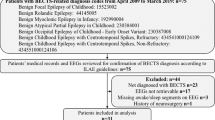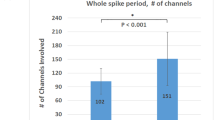Abstract
Quantification of epileptiform activity in EEG has been applied for decades. This has mainly been done by visual inspection of the recorded EEG. There have been many attempts using computers to quantify the activity, usually with moderate success. In a row of contexts, including Landau-Kleffner syndrome and the syndrome of epilepsy with continuous spike wave during slow sleep, the spike index (SI) has been applied to quantify ‹interictal nocturnal focal epileptiform activity’, which is suggested as a general term for the epileptiform activity enhanced by sleep. However, the SI has been implemented differently by different authors and has usually not been well described and never properly defined. This study suggests a definition of SI that gives a semiautomatic and relatively robust algorithm for assessment. The method employs spike detection by means of template matching of the current source density estimate. The percentage of time within an epoch with interspike interval (ISI) below a given limit, usually 3 s, is returned as the SI. This is calculated during daytime and in non-REM sleep. The standard epoch length is 10 min. The parameter selection is discussed in the context of the influence of spikes and bursts on cognition. The described method gives reproducible results in routine use, gives clinical valuable information, and is easily implemented in a clinical setting. There is only a minor added workload for the electroencephalographer.
Similar content being viewed by others
References
Aldenkamp AP, Arends J, Overweg-Plandsoen TC, van Bronswijk KC, Schyns-Soeterboek A, Linden I, Diepman L (2001) Acute cognitive effects of nonconvulsive difficult-to-detect epileptic seizures and epileptiform electroencephalographic discharges. J Child Neurol 16:119–123
Ballaban-Gil K, Tuchman R (2000) Epilepsy and epileptiform EEG: association with autism and language disorders. Ment Retard Dev Disabil Res Rev 6:300–308
Besag FM (2004) Behavioral aspects of pediatric epilepsy syndromes. Epilepsy Behav 5(Suppl 1):3–13
Binnie CD, Marston D (1992) Cognitive correlates of interictal discharges. Epilepsia 33(Suppl 6):11–17
Bureau M (1995) Definition of the syndrome. In: Beaumanoir A et al (eds) Continuous spikes and waves during slow sleep (CSWS). John Libbey, London, pp 17–26
Castaneda-Cabrero C, Lorenzo-Sanz G, Caro-Martinez E, Galan-Sanchez JM, Saez-Alvarez J, Quintana-Aparicio P, Paradinas-Jimenez F (2003) Electroencephalographic alterations in children with attention deficit hyperactivity disorder. Rev Neurol 37:904–908
Deonna T (2000) Rolandic epilepsy: neuropsychology of the active epilepsy phase. Epileptic Disord 2(Suppl 1):59–61
Deonna T, Beaumanoir A, Gaillard F, Assal G (1977) Acquired aphasia in childhood with seizure disorder: a heterogeneous syndrome. Neuropadiatrie 8:263–273
Flanagan D, Agarwal R, Wang YH, Gotman J (2003) Improvement in the performance of automated spike detection using dipole source features for artefact rejection. Clin Neurophysiol 114:38–49
Gabor AJ, Seyal M (1992) Automated interictal EEG spike detection using artificial neural networks. Electroencephalogr Clin Neurophysiol 83:271–280
Goldsmith IL, Zupanc ML, Buchhalter JR (2000) Long-term seizure outcome in 74 patients with Lennox-Gastaut syndrome: effects of incorporating MRI head imaging in defining the cryptogenic subgroup. Epilepsia 41:395–399
Gotman J, Gloor P (1976) Automatic recognition and quantification of interictal epileptic activity in the human scalp EEG. Electroencephalogr Clin Neurophysiol 41:513–529
Gotman J, Wang LY (1991) State-dependent spike detection: concepts and preliminary results. Electroencephalogr Clin Neurophysiol 79:11–19
Holmes GL, Lenck-Santini PP (2006) Role of interictal epileptiform abnormalities in cognitive impairment. Epilepsy Behav 8:504–515
Hommet C, Billard C, Barthez MA, Gillet P, Perrier D, Lucas B, de Toffol B, Autret A (2000) Continuous spikes and waves during slow sleep (CSWS): outcome in adulthood. Epileptic Disord 2:107–112
ILAE (1989) Proposal for revised classification of epilepsies and epileptic syndromes. Commission on classification and terminology of the international league against Epilepsy. Epilepsia 30:389–399
Larsson PG, Wilson JA (2005) Is sleep activated epileptic activity in children a common feature that is seldom diagnosed? Epilepsia 49:382
Lewine JD, Andrews R, Chez M, Patil AA, Devinsky O, Smith M, Kanner A, Davis JT, Funke M, Jones G, Chong B, Provencal S, Weisend M, Lee RR, Orrison WW Jr (1999) Magnetoencephalographic patterns of epileptiform activity in children with regressive autism spectrum disorders. Pediatrics 104:405–418
Malow BA, Kushwaha R, Lin X, Morton KJ, Aldrich MS (1997) Relationship of interictal epileptiform discharges to sleep depth in partial epilepsy. Electroencephalogr Clin Neurophysiol 102: 20–26
Malow BA, Lin X, Kushwaha R, Aldrich MS (1998) Interictal spiking increases with sleep depth in temporal lobe epilepsy. Epilepsia 39:1309–1316
Mariotti P, Della Marca G, Iuvone L, Mennuni GF, Guazzelli M, Marchetti S, Mazza S (2000) Is ESES/CSWS a strictly age-related disorder? Clin Neurophysiol 111:452–456
Matricardi M, Brinciotti M, Paolella A, Porro G, Benedetti P (1989) Neuropsychological correlates of subclinical paroxysmal EEG activity in children with epilepsy. 2: Quantitative aspects. Funct Neurol 4:241–246
Mirsky AF, Vanburen JM (1965) On the nature of the” absence” in centrencephalic epilepsy: a study of some behavioral, electroencephalographic and autonomic factors. Electroencephalogr Clin Neurophysiol 18:334–348
Nobili L, Ferrillo F, Baglietto MG, Beelke M, De Carli F, De Negri E, Schiavi G, Rosadini G, De Negri M (1999) Relationship of sleep interictal epileptiform discharges to sigma activity (12–16 Hz) in benign epilepsy of childhood with rolandic spikes. Clin Neurophysiol 110:39–46
Panayiotopoulos CP (2005) The epilepsies: seizures, syndromes and management. Bladon Medical publishing, Oxfordshire
Panayiotopoulos CP (2007) Landau-Kleffner sydnrome. In: A clinical guide to epileptic syndromes and their treatment, 2nd edn. Springer-Verlag, London, pp 249–254
Patry G, Lyagoubi S, Tassinari CA (1971) Subclinical “electrical status epilepticus” induced by sleep in children. A clinical and electroencephalographic study of six cases. Arch Neurol 24:242–252
Pfurtscheller G, Fischer G (1978) A new approach to spike detection using a combination of inverse and matched filter techniques. Electroencephalogr Clin Neurophysiol 44:243–247
Pfurtscheller G, Lopes da Silva FH (1999) Functional meaning of event-related desynchronization (ERD) and synchronization (ERS). 6:51–65
Rugland AL (1990) Neuropsychological assessment of cognitive functioning in children with epilepsy. Epilepsia 31(Suppl 4): 41–44
Sammaritano M, Gigli GL, Gotman J (1991) Interictal spiking during wakefulness and sleep and the localization of foci in temporal lobe epilepsy. Neurology 41:290–297
Scherg M, Ille N, Bornfleth H, Berg P (2002) Advanced tools for digital EEG review: virtual source montages, whole-head mapping, correlation, and phase analysis. J Clin Neurophysiol 19:91–112
Scholtes FB, Hendriks MP, Renier WO (2005) Cognitive deterioration and electrical status epilepticus during slow sleep. Epilepsy Behav 6:167–173
Silvestri R, Gagliano A, Calarese T, Arico I, Cedro C, Condurso R, Germano E, Vita G, Tortorella G (2007) Ictal and interictal EEG abnormalities in ADHD children recorded over night by video-polysomnography. Epilepsy Res 75:130–137
Siniatchkin M, Moeller F, Jacobs J, Stephani U, Boor R, Wolff S, Jansen O, Siebner H, Scherg M (2007) Spatial filters and automated spike detection based on brain topographies improve sensitivity of EEG-fMRI studies in focal epilepsy. Neuroimage 37:834–843
Sofijanov N, Emoto S, Kuturec M, Dukovski M, Duma F, Ellenberg JH, Hirtz DG, Nelson KB (1992) Febrile seizures: clinical characteristics and initial EEG. Epilepsia 33:52–57
Tassinari CA, Bureau M, Dravet Ch, Dalla Bernardina B, Roger J (1985) Epilepsy with continues spike and waves during slow sleep. In: Roger J, Dravet Ch, Bureau M, Dreifuss FE, Wolf P (eds) Epileptic syndroms in infancy, childhood and adolescense. John Libbey Eurotext, London and Paris, pp 194–204
Tassinari CA, Terzano G, Cappochi G, Dalla Bernardina B, Vigevano F, Daniele O, Valladier C, Dravet Ch (1977) Epileptic seizures during sleep in children. In: Penry JK (ed) Epilepsy, the 8th international symposium, Raven press, New York, pp 345–354
Tzallas AT, Oikonomou VP, Fotiadis DI (2006) Epileptic spike detection using a Kalman filter based approach. Conf Proc IEEE Eng Med Biol Soc 1:501–504
Van Hirtum-Das M, Licht EA, Koh S, Wu JY, Shields WD, Sankar R (2006) Children with ESES: variability in the syndrome. Epilepsy Res 70(Suppl 1):S248–S258
Watanabe K (1989) The localization-related epilepsies: some problems with subclassification. Jpn J Psychiatry Neurol 43:471–475
Wilson JA, Larsson PG, Bang-Kittelsen G, Eriksson AS, Brandt-Hansen P (2005) Common disorders of learning or behaviour and epileptic activity during sleep. Epilepsia 49:234
Acknowledgment
We want to thank Svein I. Johannessen for discussions and help in preparation of this manuscript. There are no financial interests, pending patents or other interests in this study.
Author information
Authors and Affiliations
Corresponding author
Rights and permissions
About this article
Cite this article
Larsson, P.G., Wilson, J. & Eeg-Olofsson, O. A New Method for Quantification and Assessment of Epileptiform Activity in EEG with Special Reference to Focal Nocturnal Epileptiform Activity. Brain Topogr 22, 52–59 (2009). https://doi.org/10.1007/s10548-008-0072-3
Received:
Accepted:
Published:
Issue Date:
DOI: https://doi.org/10.1007/s10548-008-0072-3




